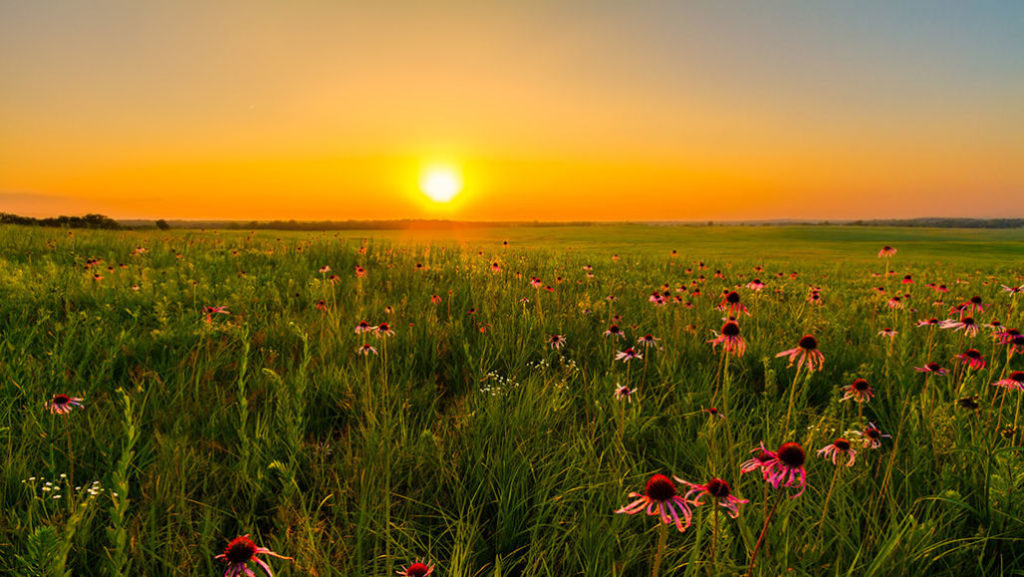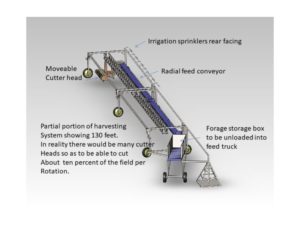Imagine an irrigation system that does not rely on clear water to run through its small tubing orifices, but rather can provide a nutritious ‘dirty’ water, filled with fine rock dust and other particulates that can optimally feed soil microbes. That will be just one of many benefits with David Munson’s Prairie Grass Systems.
“We take a water slurry mix and inject it under the plants to provide a little bit of water to the plants, but also food for the soil organisms to attack the rock dust and feed the plants,” he says about his patented invention that allows for maximum production of forage crops for cattle — native prairie grasses ideally — without cutting or grazing those plant species out of existence. “Prairie grass gets killed out by hard grazing.”
According to Munson, president of the Get Real Alliance, his invention includes overhead support frames to hold up cutter-heads to cut forage at any desired height for optimal growth and use. Cutting forage several feet high facilitates rapid regrowth and better-quality grasses, which ultimately eliminates reliance on crops such as corn for livestock feed — something that is better for the local ecosystem, as well as for the cattle.
“It solves all the problems we face of soil loss and nutrients depletion, and use of agricultural chemicals to try and grow crops not native to the region. Corn is not a crop that evolved in nature in the Midwest of the U.S. Native prairie grasses existed for thousands of years once soil reformed after the [Last Glacial Maximum]. The optimal crop to come in and feed millions of buffalo was native prairie grass. It’s super nutritious, but it can’t stand continuous grazing.”
He adds: “Cattle love it, because it’s the most nutritious grass, but they’ll literally eat it to the ground, which will deny [the grass] roots of energy and it just dies out.”
Break
‘Beefed up’ irrigator
Once built, each Prairie Grass Systems device would resemble a “beefed up” version of a conventional irrigation system, notes Munson. Each unit includes the addition of grass-cutters travelling in set arches, moving slightly into new arches after each revolution and repeatedly mowing the grass at set heights, with the clippings hauled off as cattle feed. “The grass has a chance to regrow, build roots and put carbon into the soil, and build up soil fertility.”
Since this system runs on set tracks, which are distantly spaced, most of the prairie grass is not compacted by either tires or bovine hooves across the fields, he says, meaning that soils become “airy and uncompacted” for optimal water and air penetration, which facilitates maximum vegetation growth.
“Because the native prairie was a polyculture of many plants, lagoons can be included to produce the needed fertilizer for the ground, and the needed nitrogen can be produced in lagoons in the mixture. And so, you have a situation where you can produce a tremendous amount of beef without fertilizer and without chemicals.”
He adds: “If you keep animals in confinement, then you can gather all the manure and bio-digest it for renewable natural gas to provide power. Effluent from the bio-digester is a rich fertilizer that my system can use and inject into fields, providing more fertility and a kind of nutrient cycle.”
Break
Texas pilot
 Ultimately, the Texas engineer and inventor envisions a higher-end, ethically-superior means of producing beef that, in part, incorporates the inclusion of natural grasses into the diet of cattle. Fortunately, once he secures funds to build a prototype, Munson has found a fellow Lone Star State rancher who is willing to pilot Prairie Grass Systems.
Ultimately, the Texas engineer and inventor envisions a higher-end, ethically-superior means of producing beef that, in part, incorporates the inclusion of natural grasses into the diet of cattle. Fortunately, once he secures funds to build a prototype, Munson has found a fellow Lone Star State rancher who is willing to pilot Prairie Grass Systems.
“He’s putting in a slaughterhouse for cattle on his property, and planning on raising and finishing grass-fed beef and letting them walk to the slaughterhouse for an optimal stress-free final day, where they won’t be herded into a big truck and subjected to all that stress,” he says, adding the rancher also has an abundance of freshwater on his property, which he intends to use for raising steelhead trout onsite in large concrete tanks.
“[The rancher] will take water from the fish tanks, which has fish waste in it, and irrigate his fields with it. It would be ideal for my system [to] constantly irrigate the prairie grass with nutrient-rich water.”
Break
Carter Haydu is a journalist and professional writer with more than 13 years of experience. Since 2012, he has written primarily on the Alberta energy sector for a Calgary-based trade publication. Much of his work has dealt with environmental issues facing the upstream oil and gas industry. In 2018, Carter attained a technical writing certificate from a reputable Canadian university. He hopes his skillset can support RTE’s sustainable initiatives.



